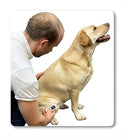Usability and reliability of a new goniometer tool based on an inertial sensor unit
Authors: Charles Fattal: CRF La Châtaigneraie (2019)
Link to study: here.
Abstract
The main objective of the study, initiated at CRF La Châtaigneraie Menucourt, is to evaluate the usability of EasyAngle to re-educate and compare metrological qualities to those of the goniometer reference with rotation axis (metallic) and the most commonly used goniometer (plastic)
Assumption is made that the EasyAngle® Goniometer stands out as a more ergonomic tool more reliable and more precise, the graduation of these 2 last goniometers being 2 in 2 °.
As for the smartphone, it has been removed from comparison because it does not meet any criteria hygiene in force in establishments health.
Methods
Examiners have previously benefited in training on the use of the EasyAngle, complete with a written guide. The basics of the practice of classical direction finding have been reviewed in order to ensure that in accordance with the original recommendations of Moore to which refers to the work of Norkin et al.
It's through a study of properties metrology that professionals in the field of education were made to use repeated and comparative the Easy Angle device. The objective is to study the reproducibility of measurement and response to the change of the EasyAngle versus the manual reference goniometer (stainless steel, full circle) and the usual goniometer (plastic).

Results
The study involved 55 patients responding to inclusion criteria mentioned above: 30 have been operated on for knee arthroplasty and 25 hip arthroplasty. Twenty physiotherapists and 2 doctors were associated with the metrological study. It's based onb repeated experience with 55 patients that the usability of the device has been appreciated.
The opinion of the 2 doctors was not taken into account in order to rely on a group return homogeneous group of physiotherapists.
Conclusion
At this stage of the data analysis, nothing can not be advanced on the metrological qualities Easy Angle, this device appears obviously attractive and promising for the therapist looking for one measure at a time accurate and fast to collect. Its ergonomics and the gestural economy it induces should limit the risk of error, encourage measurement and traceability.
It remains to demonstrate its metrological qualities which have already been strongly suggested in unfortunately unpublished studies at this day. Exploitation of the results is in progress.










